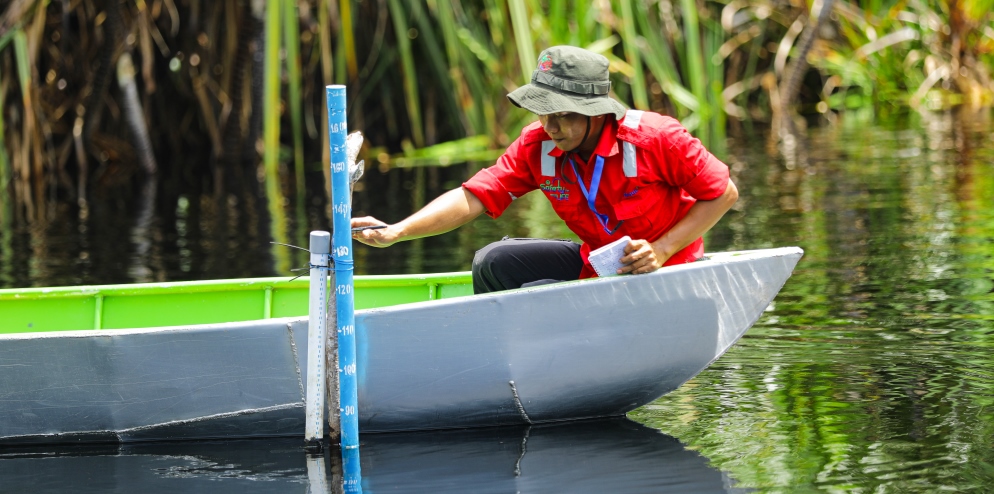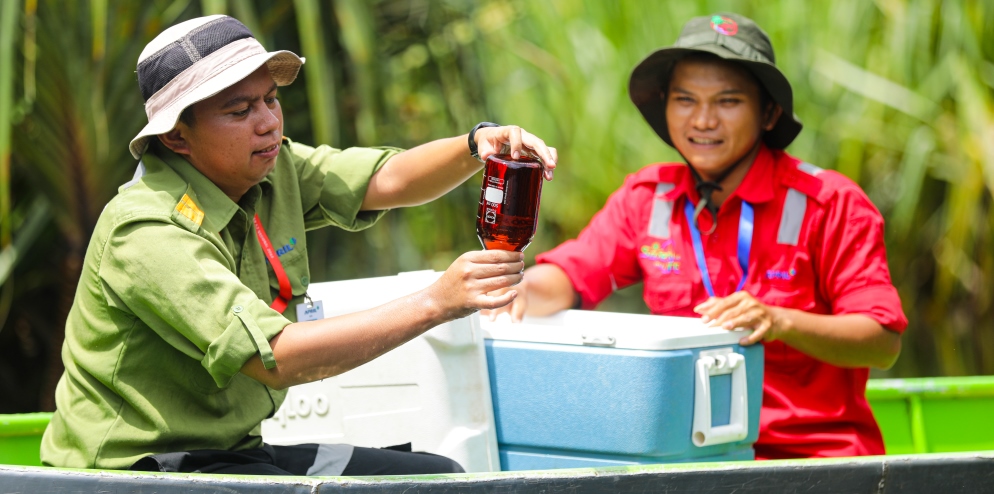December 12, 2019
With over 800 species of animals and plants living in Restorasi Ekosistem Riau (RER), the availability of water is essential for their continued survival.
RER’s concession area in the Kampar Peninsula is mostly tropical peatland, which is over 90 per cent water.
Human use of peatland over the past few decades has involved peat drainage through man-made canals, in an attempt to make land more suitable for agriculture or habitation, or for transporting timber from inside the forest to processing points on rivers.
Dry peat is highly flammable, meaning that fires can easily take place in areas of drained peatland, especially during droughts. Once this has happened, the fires are incredibly difficult to extinguish as they are able to burn underground.
Therefore, peatland, when kept wet, helps in the prevention of fires and reduction or elimination of potential carbon emissions from decomposing organic matter in dry or burned peat.

RER is committed to monitoring water levels and availability in our forests, as a preventive measure against the risk of forest fires. These efforts have led to positive results, as there have been zero fires within its concession areas since 2013.
Having high water levels in the forest also mean it can continue to thrive and support wildlife, and reduces the risk of ground subsidence.
Dian Andi Syahputra, RER Assistant Environment Officer, who is part of the water monitoring team, said the team monitors the water levels in RER everyday by measuring the water table in the forest.
“Water table means the level of water above the surface of the ground. We usually measure the height of the water table daily to see how much the water volume in the forest has fluctuated,” he said.
Dian explained that the water table in a forest can vary depending on the amount of rainfall received. During the wet season, the water table may be several centimetres above the peat soil surface. However, in the dry season, the water table can drop as much as 150 cm below the surface, making the dry peatland more susceptible to fire.
To monitor the water table, the RER team uses a series of dip wells which are inserted into the peat soil. These wells have markings which allow for the measurement of the water level.
“If water levels in the forest are low, then the team can be more alert about taking early and additional precautions to prevent the possibility of any fire happening on the dry land,” Dian said.
One way they do this is by increasing the rangers’ patrols around the forest to look for warning signs.
“The low water levels we’ve been having in RER in 2019 are considered dangerous, as we faced a long drought which can cause our peat forests to more vulnerable to fire,” he said.
“At the moment, it is raining everyday but this has not significantly impacted the water table, as the water levels of the rivers have only improved slightly from the rain,” Dian added.
To improve water levels, the RER team also conducts canal blocking work. RER works to raise water levels by using sandbags to create dams along the old man-made canals which drain water away from the forest. These dams slow the flow of water and therefore help the peat to retain moisture longer.

In addition to water levels, the team also checks the quality of water in the RER rivers every six months by taking water samples. These water samples are then sent to a laboratory in Pekanbaru for analysis of the number of solids, hydrogen and oxygen levels, as well as chlorine levels.
The information regarding the water levels and river water quality in RER is reported to Indonesia’s Ministry of Environment and Forestry twice a year.
This helps RER to ensure that it complies with local government regulations for sustainable forest management, as well as to assess any impact to the ecosystem.
Typically, there are little to no changes in RER’s water quality, which has so far been good, Dian said.